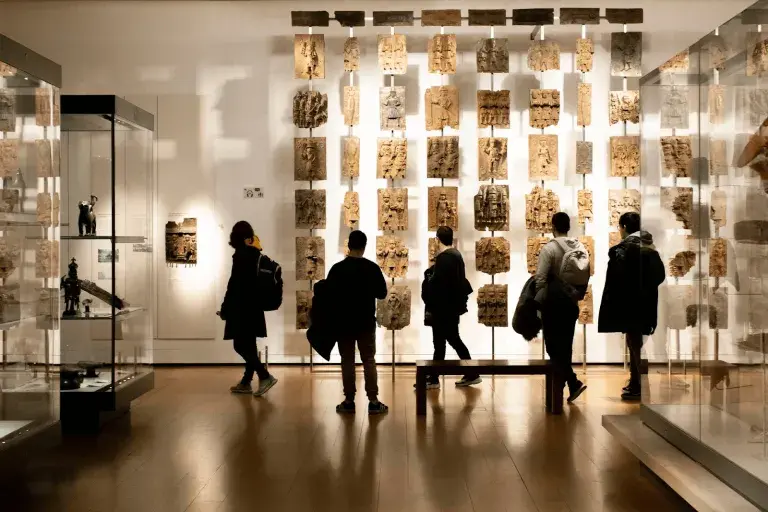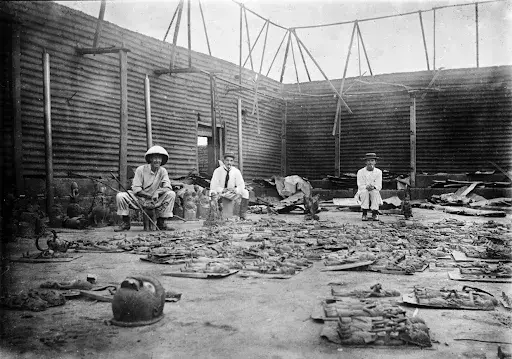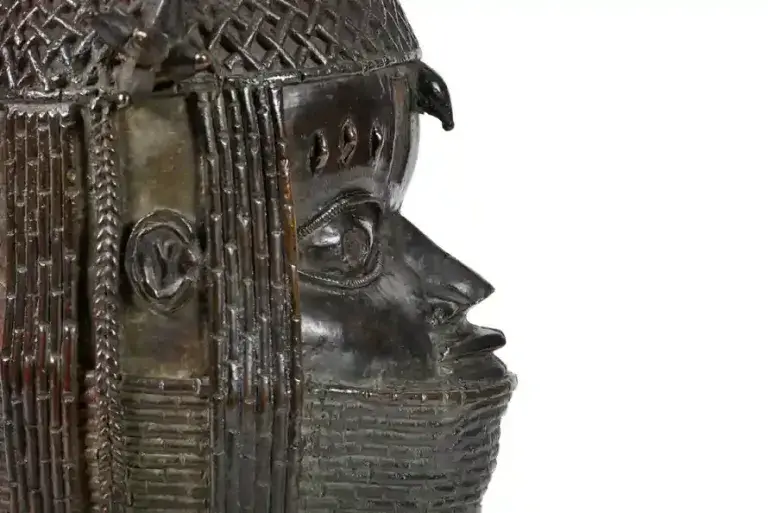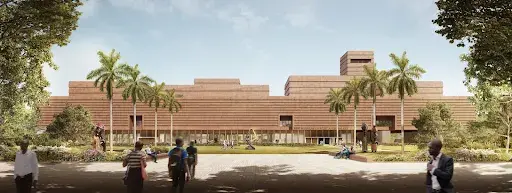Benin Bronzes and the Auction World: Past, Present, and Future
Movements to repatriate the Benin Bronzes have been around since British soldiers forcibly took the works from their homeland in 1897. Almost nothing has changed in over a century. However, activism rekindled in recent years. Greater awareness of history paired with the rising global movement for racial justice has pushed the Benin Bronzes back into the mainstream.
How were the Benin Bronzes scattered, and where should they go? Who bears responsibility for their fate? As the art world considers these questions, Auction Daily investigates the Benin Bronzes’ history, as well as their connection to the auction industry.

History of the Benin Bronzes
The Kingdom of Benin was among the most advanced civilizations in the world. The capitol was known for its elaborate walls, street lighting system, diplomacy tactics, and artistic guilds. These artisans made countless works for the Oba and his royal palace. The pieces held artistic, cultural, and religious significance.
The once-thriving Kingdom of Benin faced colonialism and rising European powers in the 1800s. Conflicts with the British increased. Everything changed in 1897 when minor clashes between British soldiers and Benin warriors dangerously escalated. Intentional fires spread out of control and razed both the capitol and the palace. More than anything else, the Kingdom of Benin mourned the devastating loss of life. British soldiers looted around 2,500 artifacts and artworks in the aftermath and shipped them back to England. The sale of these works paid off the costs of the conflict.
From the start, survivors of the 1897 raid spoke out against the open theft of their cultural works. That criticism never ceased; even as the Kingdom of Benin fell, the British colonized the region, and present-day Nigeria struggled for its independence. Over the years, many acknowledged the depth of the loss. “[The stolen works] were our documents, our archives, the ‘photographs’ of our kings. When they were taken our history was exhumed,” Victor Ehikhamenor, a Nigerian artist, told the BBC earlier this year.
The Benin Bronzes are now scattered between museums, private collections, and everywhere in between. The British Museum holds most of the looted objects, followed by the Ethnological Museum of Berlin and the Pitt Rivers Museum in Oxford.

How Are Auction Houses Involved?
Museums usually receive the harshest criticism about the Benin Bronzes. However, many major auction houses facilitated the distribution and privatization of the works. After the 1897 raid, some bronzes, ivory pieces, and brass castings entered the auction market. Few records of these sales survive.
The 20th century brought better documentation alongside a swell of interest in “tribal art.” Auction prices for Benin Bronzes started around GBP 5,500 in the 1950s (around USD 209,000 today). Those figures climbed steadily through the 20th century. In 2007, Sotheby’s sold a Benin head sculpture for $4.7 million. The winning bidder later purchased another Benin bronze piece for $13.8 million in a private sale. Bronzes with dubious provenance appeared at auction as recently as 2020.
After each sale’s announcement, advocates call for a halt to the auction or compensation for the original owners’ descendants. This strategy is typically met with denial and dismissal. Collectors with misgivings over provenance now consign anonymously and avoid questions from the press. Auction houses tend to do the same.

Recent Controversies
While most known Benin Bronzes can be found in museums or private collections, the occasional artifact still finds its way to the market. Christie’s Paris offered several controversial artworks in late June of 2020. The Arts of Africa, Oceania, and North America sale encountered criticism almost immediately after its catalog dropped. An Edo bronze plaque made in the former Kingdom of Benin drew particular ire. Academics and activists pointed out the similarities between the bronze and other identified stolen works. This item raised considerable concern about Benin bronze statues for sale in today’s market.
While the fish-shaped bronze plaque failed to sell, other suspicious lots did. Two Igbo alusi figures sold for approximately $238,000. Nigerian academics pointed out their uncertain provenance, noting a possible looting during the Biafran War of the late 1960s. Babatunde Adebiyi, the legal adviser of the Nigerian National Commission for Museums and Monuments, agreed. “There is never going to be a universal principle that says something made by my forebears belongs to you in perpetuity because you bought it in an auction house,” he said to the BBC after the auction. “African antiquities will always be African, just like a Da Vinci will always be European.”
Others have been quick to point out the restituted art departments in many auction houses. Experts in these departments work to return Nazi-looted artworks to their proper owners. The art industry rightly values and respects that process. However, no equivalent exists for returning Benin bronze sculptures or other stolen works of African art.

Current Status of Repatriation
Activist groups such as Nigeria’s Legacy Restoration Trust (LRT) have long demanded the return of the Benin Bronzes. The repatriation movement’s energy picked up during the civil unrest and worldwide protests against racism and white supremacy in 2020. Museums, collectors, and auction houses felt mounting pressure to take action.
After years without accountability, some institutions are taking steps toward repatriation. The University of Aberdeen, a Scottish research college, pledged in March of 2021 to return a Benin bronze bust to Nigeria. The school joins other independent UK institutions in taking steps to return the stolen bronzes. Germany also announced plans to repatriate Benin artworks in national collections. Alhaji Lai Mohammed, Nigeria’s minister of information and culture, applauded the moves but noted how much is left to do. He told The Guardian: “Other holders of Nigerian antiquity ought to emulate this to bring fairness to the burning issue of repatriation.”

The Path Forward
The extensive and bloodied history of the Benin Bronzes leaves many museums, cultural institutions, and auction houses with decisions to make. Mounting social pressure all but guarantees there will not be a return to business as usual. What is the path forward for the Benin Bronzes?
The immediate repatriation of all Benin Bronzes is the most popular option among Nigerians. Museum professionals have debunked the myth that the artifacts are safer in the West, noting the growing and robust museum network in Nigeria. A new facility designed to hold the Benin Bronzes proves this point. The planned Edo Museum of West African Art in Nigeria, designed by Ghanaian-British architect David Adjaye, can maintain hundreds of returned artworks. Adjaye states that the museum will intentionally differ from Western institutions in some respects. “It has to be for the community first,” he told The New York Times, “and an international site second.”
The auction world has a part to play in the future as well. Auction houses often bridged the gap between looters and collectors following the 1897 raid. Over the last 124 years, the Benin Bronzes slipped into auction catalogs and away from the public eye. Auction houses bear responsibility for those actions. Going forward, art world experts and collectors must verify the full provenance of items before auctioning them. Halting the sale of unverified items and establishing appropriate repatriation measures will also be necessary. These are the first but increasingly important steps to returning the Benin Bronzes to their true owners.
UPDATE DECEMBER, 2021: The movement to return the Benin Bronzes continued to gain momentum throughout 2021. Auction Daily checked on the status toward repatriation in July. Around that time, Germany’s Prussian Cultural Heritage Foundation took tangible steps to return hundreds of looted objects as soon as early 2022. New York’s Metropolitan Museum of Art soon followed suit and agreed to return three significant items from its collection.
More recently, French officials negotiated the return of 26 looted items that formerly appeared at the Quai Branly Museum in Paris. The move was universally applauded as a step forward in the repatriation movement, as well as an effort to improve relations between France and African countries. In another milestone in Benin Bronzes history, the Smithsonian Institution’s National Museum of African Art (NMAfA) in Washington, DC announced the removal of 16 potentially-looted Benin bronze sculptures from its displays. Further action to repatriate the items may follow in the coming months.
Elsewhere in the art world, activists continue to raise the alarm over sacred antiquities and Benin Bronzes for sale in the auction market. Mexican officials denounced the sale of pre-Hispanic artifacts at French auction house Artcurial. Taíno activists also protested the sale of sacred items in a recent Christie’s auction. Indigenous groups rallied and protested in person to stop the event, to no avail. However, these recent actions reflect a broader trend toward justice in the art world, starting with the Benin Bronzes and continuing far beyond.









